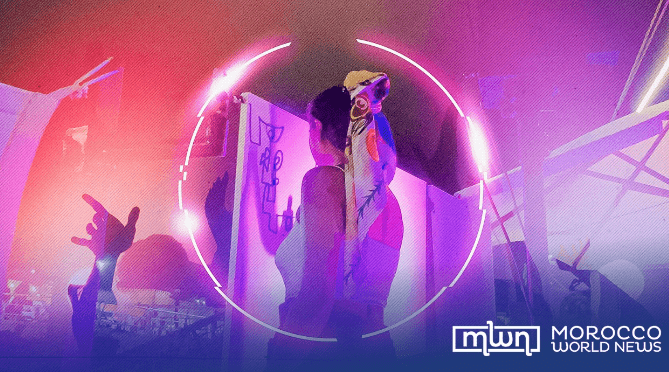Since arriving in Morocco three years ago from the United States, I’ve tried to expose myself to a range of music. I’ve written articles on a Moroccan rapper and Tunisian folk musicians, traveled to raves of varying quality in Marrakesh and Meknes, and gotten trailed by men playing gnawa music in the streets of Rabat. Even as I write this article, I’m listening to emo, which I regret because it’s not very good.
Therefore, I could hardly say no when a friend invited me to attend a dance party on August 25 at Le Dhow, a boat-shaped bar on the Rabat marina (though my dancing was quite poor then and has not improved since). The event was part of Le Dhow’s weekly “Utopia Music” series, promising a “full-women” lineup of DJs under the slogan “Future Is Female: Future Starts Now.”
My frequent attendance at raves in various corners of Morocco notwithstanding, I wouldn’t necessarily describe myself as a serious fan of techno — different types of techno always struck me as just different levels of loud.
That said, I appreciate how techno makes me feel like the protagonist of a science fiction film set on a far-off planet governed by evil cyborgs.
Moreover, the DJs at the “Future Is Female” event were quite good. I wanted to let them know, but I wasn’t sure how — that is, until an idea struck me: what if I wrote an article about them?
So here we are.
I first spoke to Meryem Bouqottaya, one of the openers for the “Future Is Female” event. Of course, the 33-year-old, Casablanca-based DJ’s fans know her as “Pepsounette.”
“I had the idea to be a DJ because music is very dear to me,” Meryem told me. “I’ve mixed different types of music for a while — hip hop, R&B, soul, and house. That’s why my music is groovy.”
Ania, a DJ who came later on in the lineup and asked that I only use her professional name in this article, told a similar story. The 29-year-old from Rabat started as a lover of music before becoming a DJ, listening at first to rock and metal. Ania later grew fascinated with electronic music and frequented DJ-led dance parties across Morocco.
“I wanted to do the same,” said Ania. “I wanted to make people dance. I wanted to make people happy. Electronic music became my way of expression. There are no vocals, so you feel the music more.”
Ania began DJing in 2018 after a friend taught her how to use a turntable. She also watched YouTube tutorials, calling herself “curious about anything related to music.” Ania soon made her way to Le Dhow, DJing at two “Utopia Music” events before participating in the one that I attended in August. However, she saw the “Future Is Female” initiative as unique.
“It can help to promote female DJs,” Ania explained. “You can’t know the female DJs in Morocco if there are no events or parties. Parties are where DJs are discovered. But I guess we need more work on this.”
Some of the biggest names in Morocco’s music scene and beyond are pushing the country toward greater recognition of its female talent.
Marjana Jaidi, a Filipina-Moroccan producer, earned a profile in the American magazine Billboard as “the woman making Morocco a dance music destination” when she organized the Oasis Festival in Marrakesh in 2020 and female DJs such as Fadoua Rasmouki have captured Moroccan and international attention.
Meanwhile, Brazilian DJ Maria Malasangre is holding women-only classes for aspiring DJs in the Moroccan resort town of Taghazout.
Building on this feminist infrastructure, Le Dhow’s “Future Is Female” event even managed to attract artists from outside the music industry. While Ania and the DJs played their sets, Hiba Baddou, a 25-year-old specialist in visual arts, performed what Le Dhow advertised as “live painting.” In tune with the music, Hiba covered canvases in cascading, mesmerizing shapes.
Last year, Hiba held an exhibition of her work under the French title “Osmoses” at the Kasbah of the Udayas, a medieval fortress visible from Le Dhow. At the “Osmoses” event, Hiba exhibited art that she made as a band performed gnawa music.
Hiba drew a direct line between her exhibition at the Kasbah and her performance at Le Dhow, describing gnawa and techno as inspiring the same “conversation between music and visuals.”
At the same time, she found herself pulled to the “Future Is Female” event’s particular, “feminine” aspects.
“I wouldn’t do this for any event,” Hiba emphasized “The people who came had the same idea as the organizers and I: women should be more valued. It’s a beautiful way to talk more about women’s condition and how we should put more of them on the scene, especially the music scene.”
Ania echoed Hiba’s sentiments: “I was so happy to be part of this, since I myself want to start my own female project.”
Despite the profile that Ania built at the “Utopia” events and other dance parties, she noted that obstacles remain to the success of female DJs: “A lot of people judge you just because you’re a woman.”
Read Also: Meet Maria Malasangre: the DJ and Producer of Taghazout’s Female-Only DJ Classes
















